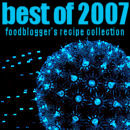 Zorra from 1 x Umrühren and Sandra from Un tocco di Zenzero have invited the food bloggers to introduce their best recipe from 2007.
Zorra from 1 x Umrühren and Sandra from Un tocco di Zenzero have invited the food bloggers to introduce their best recipe from 2007.
Difficult, very difficult. I can’t choose one: they are all mine and I wouldn’t have published them if I didn’t like them…
In autumn, I always referred to my all-time-favorite recipe, but I didn’t publish it: Quince Paste or Quince Bread.
I love these sweet and delicious little rhombs since I was a child. Before christmas my great-aunt from Munich always sent a parcel with biscuits. Those parcels weren’t very large and never contained enough quince paste. Then I vowed: „One day I will make my own! And lots of it!“
Over the years I have tried many variations, but this year I used the traditional recipe again. And these are the best ever and always will be!
The official version says to use all the remains from making quince juice (remaining fruit, peel and core) and still remove every little drop of juice and then mince it thoroughly. This quite dry stuff will be used for quince paste.
Well, since the main thing for me is not making juice as much as possible, but making quince paste, I had it a little easier.
Quince Paste
| Source: | The recipe of my great-aunt |
| categories: | Quince, Christmas |
| Servings: | 1 recipe |

Ingredients:
| 2 | kg | Quinces |
| Water | ||
| or: | ||
| 1 | kg | De-Juiced quince pulp |
| 500 | g | Sugar (depending on the amount of pulp) |
| Sugar, for coating |
Preparation:
Rub the quinces to remove the fluff and wash them. Cut into large pieces. Only remove the core, everything else may be used.
Let cook in the steam juicer until no more juice will come out. If you want, you may drain the pulp further letting it sit in a fine sieve or cloth for another day.
Weigh out the remaining quince pulp, put it into a large cooking pot and purée with a hand mixer.
Depending on the pulp’s consistency, add about half again the weight in sugar. Boil down on low heat, stirring constantly, until the pulp changes to a dark redbrown paste. This may take 2 or 3 or 4 hours.
Spread the paste 1 cm thick on plates, cover them with paper and put them in a dry place (on top of the kitchen cupboards or in the larder), letting it dry for several weeks. This is the traditional method, but unfortunately this way the paste is in danger of getting mouldy or eaten by tiny moths. So today the quince paste is usually dried by putting it into the stove for some hours with a temperature of 50°C.
This time I mixed both methods: I spread the paste on a baking tray with baking paper. Over the next weeks I put the tray into the stove whenever it had been used and was cooling down. After two weeks the paste had the right consistency: dry on the outside, but still springy when pressed.
Finally cut the paste into little rhombs and roll them in sugar.
Notes:
– Depending on your taste, you may add lemon juice, cinnamon and/or other christmas spices.
– This happened to me some years ago: When the paste gets burned, carefully remove the part which isn’t scorched and put it into another cooking pot. Do not stir-in the dark stuff: Every time you eat a piece, you’ll be annoyed.


Ein Gedanke zu „Quince Paste“